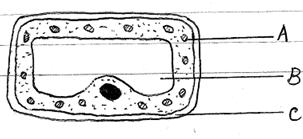Question
The figure below is a diagram of a cell as seen under the light microscope.

(a) Name three structures that shows this is a plant cell and not an animal cell.
(b) Name one chemical compound that is only found in the structure labeled A and state its function.
(c) Name the fluid in the part labeled B and state its functions.
(d) What is the main chemical compound found in the structure labeled C?
(e) Suggest why the structures labeled A would more on one side than the other side.

(a) Name three structures that shows this is a plant cell and not an animal cell.
(b) Name one chemical compound that is only found in the structure labeled A and state its function.
(c) Name the fluid in the part labeled B and state its functions.
(d) What is the main chemical compound found in the structure labeled C?
(e) Suggest why the structures labeled A would more on one side than the other side.
Answer
(a) Cell wall, chloroplast and sap vacuole.
(b) Chlorophyll – traps light energy and uses it to drive the synthesis of food materials.
(c) Cell sap;
(i) stores salts and sugars
(ii) Helps to maintain an osmotic gradient which regulates movement of water in and out the cells.
(iii) Helps to regulate the shape and turgidity of the cell.
(d) Cellulose
(e) In dim light. They move to the upper part of the cell in order to receive enough sunlight for photosynthesis.
(b) Chlorophyll – traps light energy and uses it to drive the synthesis of food materials.
(c) Cell sap;
(i) stores salts and sugars
(ii) Helps to maintain an osmotic gradient which regulates movement of water in and out the cells.
(iii) Helps to regulate the shape and turgidity of the cell.
(d) Cellulose
(e) In dim light. They move to the upper part of the cell in order to receive enough sunlight for photosynthesis.

